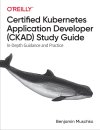Certified Kubernetes Application Developer (CKAD) Study Guide: In-Depth Guidance and Practice
Автор: Benjamin Muschko (2021)

Microservices architecture is one of the hottest areas of application development today, particularly for cloud-based, enterprise-scale applications. The benefits of building applications using small, singlepurpose services are well documented. But managing what can sometimes be enormous numbers of containerized services is no easy task and requires the addition of an “orchestrator” to keep it all together. Kubernetes is among the most popular and broadly used tools for this job, so it’s no surprise that the ability to use, troubleshoot, and monitor Kubernetes as an application developer is in high demand. To help job seekers and employers have a standard means to demonstrate and evaluate proficiency in developing with a Kubernetes environment, the Cloud Native Computing Foundation (CNCF) developed the Certified Kubernetes Application Developer (CKAD) program. To achieve this certification, you need to pass an exam. The CKAD is not to be confused with the Certified Kubernetes Administrator (CKA). While there is an overlap of topics, the CKA focuses mostly on Kubernetes cluster adminstration tasks rather than developing applications operated in a cluster. In this study guide, I will explore the topics covered in the CKAD exam to fully prepare you to pass the certification exam. We’ll look at determining when and how you should apply the core concepts of Kubernetes to manage an application. We’ll also examine the kubectl command-line tool, a mainstay of the Kubernetes engineer. I will also offer tips to help you better prepare for the exam and share my personal experience with getting ready for all aspects of it. The CKAD is different from the typical multiple-choice format of other certifications. It’s completely performance based and requires you to demonstrate deep knowledge of the tasks at hand under immense time pressure. Are you ready to pass the test on the first go?
Автор: Benjamin Muschko (2021)

Microservices architecture is one of the hottest areas of application development today, particularly for cloud-based, enterprise-scale applications. The benefits of building applications using small, singlepurpose services are well documented. But managing what can sometimes be enormous numbers of containerized services is no easy task and requires the addition of an “orchestrator” to keep it all together. Kubernetes is among the most popular and broadly used tools for this job, so it’s no surprise that the ability to use, troubleshoot, and monitor Kubernetes as an application developer is in high demand. To help job seekers and employers have a standard means to demonstrate and evaluate proficiency in developing with a Kubernetes environment, the Cloud Native Computing Foundation (CNCF) developed the Certified Kubernetes Application Developer (CKAD) program. To achieve this certification, you need to pass an exam. The CKAD is not to be confused with the Certified Kubernetes Administrator (CKA). While there is an overlap of topics, the CKA focuses mostly on Kubernetes cluster adminstration tasks rather than developing applications operated in a cluster. In this study guide, I will explore the topics covered in the CKAD exam to fully prepare you to pass the certification exam. We’ll look at determining when and how you should apply the core concepts of Kubernetes to manage an application. We’ll also examine the kubectl command-line tool, a mainstay of the Kubernetes engineer. I will also offer tips to help you better prepare for the exam and share my personal experience with getting ready for all aspects of it. The CKAD is different from the typical multiple-choice format of other certifications. It’s completely performance based and requires you to demonstrate deep knowledge of the tasks at hand under immense time pressure. Are you ready to pass the test on the first go?
Скрытое содержимое могут видеть только пользователи групп(ы): Premium, Местный, Свои
